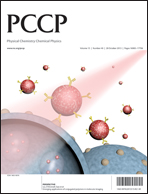Effect of donor–acceptor orientation on solvent-dependent three-photon activity in through-space charge-transfer systems – case study of [2,2]-paracyclophane derivatives†
Abstract
We study the effect of donor–acceptor orientation on solvent-dependent three-photon transition probabilities (δ3PA) of representative through-space charge-transfer (TSCT) systems, namely, doubly positively charged [2,2]-paracyclophane derivatives. Our cubic response calculations reveal that the value of δ3PA may be as high as 106 a.u., which can further be increased by a specific orientation of the donor–acceptor moieties. To explain the origin of the solvent cum orientation dependency of δ3PA, we have calculated different three-photon tensor components using a two-state model, noting that only a few tensor elements contribute significantly to the overall δ3PA value. We show that this dependence is due to the large dipole moment difference between the ground and excited states of the systems. The dominance of a few tensor elements indicates a synergistic involvement of π-conjugation and TSCT in the large δ3PA of these systems.
![Graphical abstract: Effect of donor–acceptor orientation on solvent-dependent three-photon activity in through-space charge-transfer systems – case study of [2,2]-paracyclophane derivatives](/en/Image/Get?imageInfo.ImageType=GA&imageInfo.ImageIdentifier.ManuscriptID=C3CP52696H&imageInfo.ImageIdentifier.Year=2013)

 Please wait while we load your content...
Please wait while we load your content...